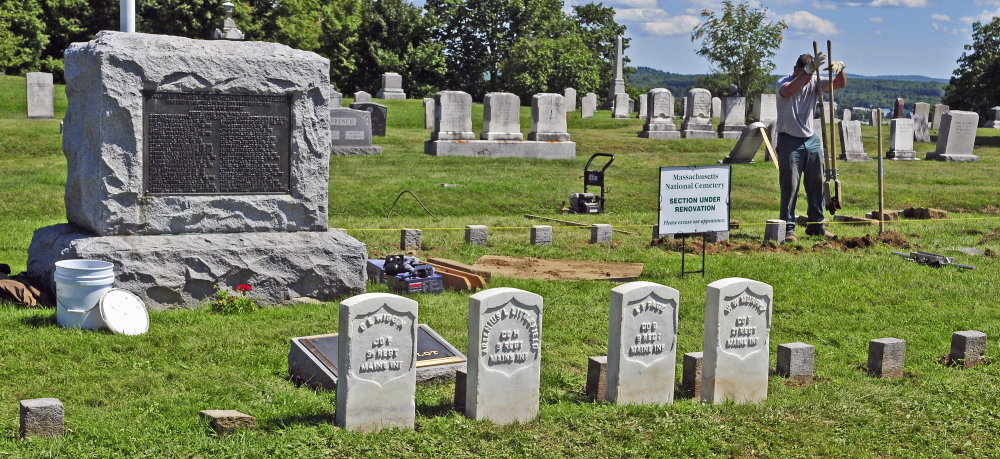Kevin Miller tamps down the dirt, muscles the headstone into place, then carefully compares it to the string he uses as a chalkline. To an observer it looks right on, but Miller sees something he doesn’t like. He grips the stone, all 140 pounds of it, and hauls it out of the ground so he can shovel in a little more dirt and tamp it down tight. Back the stone goes, and this time it lines up perfectly.
“A good caretaker can do 20 to 25 stones a day,” Miller says in between tamps.
Miller, maintenance supervisor for the Massachusetts National Cemetery, is working this week at Mount Pleasant Cemetery in Augusta. Although Mount Pleasant is primarily a civilian cemetery, the U.S. Department of Veterans Affairs maintains two lots that in the 1800s were donated to the federal government. Both lots, as well as the nearby Togus National Cemetery, fall under the care of the Massachusetts National Cemetery.
“What we had here was in a state of disrepair,” said Miller, who was assigned the task of cleaning and resetting the stones at both of the Mount Pleasant lots.
Mount Pleasant Cemetery Soldiers’ Lot, according to the National Cemetery Association, was carved out of the city-owned Mount Pleasant Cemetery in 1862. The city donated four lots totaling 1,500 square feet to the federal government. In 1870, the city donated an additional six lots, just east of the original plot, totaling 2,500 square feet.
There are 60 graves in the eastern lot and 29 in the smaller one.
The U.S. government in 1906 erected a monument in the eastern lot to honor Union soldiers who died in Augusta hospitals during the Civil War. The monument includes a plaque listing the names of 40 Union soldiers.
The Seth Williams post of the Grand Army of the Republic erected a monument in the western lot, but the date of that installation is unknown.
The stones, which include the white upright variety and smaller granite markers, are not placed in concrete, making them susceptible to frost heaves. When Miller and his colleague Chris Rastallis showed up this week, the stones, particularly in the eastern lot, were badly out of alignment. Miller was unsure when the stones had last been reset.
“We were both pretty appalled,” he said.
Miller, 42, an Air Force veteran, has worked for Massachusetts National Cemetery for a little less than two years. A self-described history buff, he said the job has become a passion.
“National cemeteries are nothing but a historical melting pot,” he said.
Taking care of the stones also allows Miller to exercise his desire to honor the men and women who have served in the U.S. military.
“It’s cathartic,” he said. “It’s brothers and sisters taking care of their brothers and sisters.”
The work may be enjoyable, but it’s not easy. Miller’s equipment consisted of a manual post-hole digger and tamper, along with shovels and rakes. The only power tool is a pressure washer used to clean the stone. The smaller stone markers, which Miller was aligning Wednesday afternoon, weigh about 140 pounds. The larger white, upright markers each weigh about 260 pounds.
“There’s only one way to do it. That’s what we call the Amish way,” Miller said, smiling. “There’s no shortcut for real labor.”
Miller said crews sometimes can use equipment, such as an excavator, but every job requires constant assessment. Miller said the overriding goals, always, are to serve the veterans and protect the cemetery turf. Sometimes that means laying thousands of feet of plywood road to gain access to an area without damaging the turf. Sometimes, as at Mount Pleasant Cemetery, it means doing everything by hand.
“There may be 50 ways to do something, but there only one right way,” Miller said. “It can be very stressful.”
Craig Crosby can be contacted at 621-5642 or at:
ccrosby@centralmaine.com
Twitter: @CraigCrosby4
Send questions/comments to the editors.





